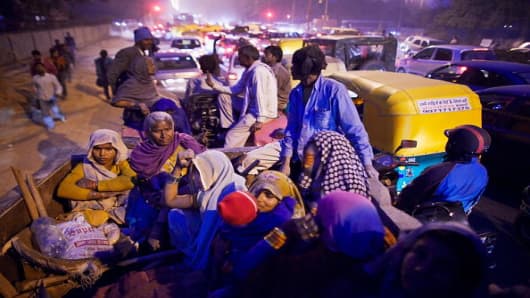The children begin arriving every year in mid-May, brought to an overburdened hospital here in one of India's most impoverished areas by their panic-stricken mothers. Seemingly healthy hours earlier, most have lapsed into a coma, punctuated by convulsions.
Doctors work to calm the convulsions and keep the children hydrated, but then have to watch helplessly along with the anguished parents as a third of their young patients die, often within hours. Then, as suddenly as it started, the mysterious outbreak stops with the onset of the monsoon rains this month. No one knows why.
The mud-and-bamboo huts in this part of India cradle more dying children than anywhere in the world, with diarrhea and malnutrition long ranking as the region's great scourges. But now, this unknown killer is stalking the very young.
Although public health statistics are unreliable here, the disease is believed to infect tens of thousands of people a year and kill thousands.
All doctors know is that the illness is a form of brain swelling, or encephalitis, but that is a huge category, covering a wide spectrum of diseases. Doctors have tested for known causes of brain swelling, including meningitis and Japanese encephalitis, but the tests almost always come back negative. India's top health officials say the disease, known officially as acute encephalitis syndrome, has them stumped.
(Read More: At least 36 dead in stampede at massive Indian hindu festival)
"This outbreak happens every year, and we have not been able to identify the cause or link even a single factor responsible," Dr. L. S. Chauhan, the director of the National Center for Disease Control in India, said in an interview.
Dr. Chauhan hopes to change that. With help from the Centers for Disease Control and Prevention in Atlanta, he started a program this year to train an elite cadre of disease sleuths, part of a recently organized Epidemic Intelligence Service in India that he hopes will eventually undertake the investigations of India's estimated 1,500 epidemics.
But the outbreak in Muzaffarpur is slowly spreading to neighboring areas, and Dr. Chauhan has thrown everything he can at it, assigning all seven of his trainees — each already an accomplished physician. Experts from the C.D.C. are advising them, and their work is being closely followed by concerned officials in the United States.
The first reports of this mysterious illness date to 1995, when nearly 1,000 children were sickened and 300 died in Muzaffarpur's three hospitals. Smaller epidemics have followed almost every year since.
Officials say they do not know whether the illness began in 1995 or had simply gone unnoticed before. Not only has it spread to nearby areas, but researchers have also recently found similar cases in neighboring Nepal. Some outbreaks in India have gone unreported because officials suppressed any mention for fear of prompting panic or criticism.
"India has a huge problem with encephalitis," said Dr. Rajesh Pandey, one of the epidemiologists camped out in Muzaffarpur, "and it's not something almost anyone knows about."
(Read More: Major flu outbreak threatens to slow economy further)
The illness is often confused with Japanese encephalitis, which generally arrives just after the start of the monsoons and peaks in the fall, as it is spread by mosquitoes that breed in standing water. But this affliction starts a couple of months earlier and ends with the monsoon.
"This is a real mystery," Dr. Thomas R. Frieden, the C.D.C. director, said in a telephone interview. "We're not sure we'll be able to solve it, but at least we can unleash the best epidemiological tools we have to try to answer the question."
Dr. Chauhan's team has been given a rustic guesthouse next to a hospital here. There is no air-conditioning, the beds sag and the electricity is fitful. But there is an urgency to the doctors' work. They gather almost every night in a small dining room to update crude posters with information about each case and debate their theories. A new virus, an old bacteria, litchis, alcoholic tree sap, heat, pesticides, rats, bats and sand flies are among the suspected causes.
In the nearby hospital, parents say in hushed tones that a ghost must be angry. Some paint black spots on siblings' foreheads to ward off the evil eye.
Given the suddenness with which the illness strikes, their superstition is understandable. At 11:30 p.m. on June 10, Chhotu Kumar, 3 years old, was sleeping beside his mother and two brothers in their hut in the village of Ganti Vishanpur when he let out a scream and went into convulsions. Chhotu's father, Vijay Majhi, took the boy to a hospital.
Several hours later, Chhotu's brother, Golu, 5, screamed louder, convulsed and went limp. His panicked mother left her 2-month-old with a relative and took Golu to the hospital.
Intensive medication and intravenous fluids stopped Chhotu's convulsions and cured his dehydration, said Dr. Mohan Kumar, a member of the team.
"I thought the child was O.K.," Dr. Kumar said.


